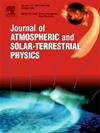基于天气和空气污染物的城市和泥炭地地区漫射太阳辐射决定因素
IF 1.8
4区 地球科学
Q3 GEOCHEMISTRY & GEOPHYSICS
Journal of Atmospheric and Solar-Terrestrial Physics
Pub Date : 2025-01-10
DOI:10.1016/j.jastp.2025.106419
引用次数: 0
摘要
了解太阳辐射的可变性对于有效地规划和管理太阳能系统至关重要。太阳辐射向地面的传输通常受到多种因素的影响。本研究探讨了天气和空气污染对城市和泥炭地两种不同环境中太阳漫射辐射量的影响。雅加达的两个监测站(Kemayoran和Jagakarsa)代表城市地区,而南加里曼丹的两个监测站(Pinang Habang和Jambu)代表泥炭地地区。使用三种基于机器学习的模型来估计与天气和空气污染相关的太阳漫射辐射量,即随机森林(RF)、k近邻(KNN)和光梯度增强机(LGBM)。使用各种预测变量组合进行了五个实验,包括温度、空气污染物和云量。实验结果突出了污染物作为预测因素的重要性。所有模式在捕获四个站点的太阳漫射辐射变异性方面都显示出可靠的结果,表明尽管具有相似的年度模式,但城市地区接收的太阳漫射辐射量约为泥炭地地区的一半。其中,射频模型与实际值的相关系数最高,误差最小。在研究的地点中,泥炭地地区的预测与参考模式密切相关。此外,本研究发现CO是预测城市地区太阳漫射辐射的主要因子。不同的是,PM2.5主要影响农村地区的太阳漫射辐射。这项研究强调了空气污染物,特别是一氧化碳和PM2.5在决定太阳辐射水平方面的关键作用,而太阳辐射水平反过来又影响太阳能系统的效率。本文章由计算机程序翻译,如有差异,请以英文原文为准。
Determinants of diffuse solar radiation in urban and peatland areas based on weather and air pollutants
Understanding solar radiation variability is essential for efficiently planning and managing solar energy systems. The transmission of solar radiation to the ground is generally affected by a variety of factors. This research deals with the impacts of weather and air pollution on the amount of diffuse solar radiation across two distinct environments, i.e., urban and peatland areas. Two stations in Jakarta, Kemayoran and Jagakarsa represent the urban area, while two stations in South Kalimantan, Pinang Habang and Jambu, represent the peatland area. Three machine learning-based models were used to estimate the amount of diffuse solar radiation related to weather and air pollution, namely Random Forest (RF), K-nearest neighbor (KNN), and Light Gradient Boosting Machine (LGBM). Five experiments were carried out using various combinations of predictor variables, including temperature, air pollutants, and cloud cover. The results of the experiments highlighted the significance of pollutants as predictive factors. All models demonstrated reliable results in capturing the variability of diffuse solar radiation in four stations, revealing that urban areas receive approximately half the amount of diffuse solar radiation compared to peatland areas, despite sharing a similar annual pattern. Among the models, RF model achieved the highest correlation coefficient with actual values, yielding the least error. Among the sites studied, the predictions from peatland areas closely aligned with the reference pattern. Furthermore, this study found that CO is the primary factor in predicting diffuse solar radiation in urban areas. Differently, PM2.5 mostly impact the diffuse solar radiation in rural areas. This research underscores the critical role of air pollutants, particularly CO and PM2.5, in determining solar radiation levels, which in turn affects the efficiency of solar energy systems.
求助全文
通过发布文献求助,成功后即可免费获取论文全文。
去求助
来源期刊

Journal of Atmospheric and Solar-Terrestrial Physics
地学-地球化学与地球物理
CiteScore
4.10
自引率
5.30%
发文量
95
审稿时长
6 months
期刊介绍:
The Journal of Atmospheric and Solar-Terrestrial Physics (JASTP) is an international journal concerned with the inter-disciplinary science of the Earth''s atmospheric and space environment, especially the highly varied and highly variable physical phenomena that occur in this natural laboratory and the processes that couple them.
The journal covers the physical processes operating in the troposphere, stratosphere, mesosphere, thermosphere, ionosphere, magnetosphere, the Sun, interplanetary medium, and heliosphere. Phenomena occurring in other "spheres", solar influences on climate, and supporting laboratory measurements are also considered. The journal deals especially with the coupling between the different regions.
Solar flares, coronal mass ejections, and other energetic events on the Sun create interesting and important perturbations in the near-Earth space environment. The physics of such "space weather" is central to the Journal of Atmospheric and Solar-Terrestrial Physics and the journal welcomes papers that lead in the direction of a predictive understanding of the coupled system. Regarding the upper atmosphere, the subjects of aeronomy, geomagnetism and geoelectricity, auroral phenomena, radio wave propagation, and plasma instabilities, are examples within the broad field of solar-terrestrial physics which emphasise the energy exchange between the solar wind, the magnetospheric and ionospheric plasmas, and the neutral gas. In the lower atmosphere, topics covered range from mesoscale to global scale dynamics, to atmospheric electricity, lightning and its effects, and to anthropogenic changes.
 求助内容:
求助内容: 应助结果提醒方式:
应助结果提醒方式:


